#queer vernacular
Text
-fae
#aave#african american vernacular english#black lives matter#blm#black lives still matter#black history#drag balls#queer history
4K notes
·
View notes
Text
i need to do like a painting style drawing of bryce w a very artsy type of pose but it's literally just him draped across their beanbag bc he is gay
#choices fandom cant take a joke or interesting vernacular so before you shit your pants no hes not gay hes still pan in my hc#but anyway he cannot sit normal in a chair#he is Not beating the queer allegations#also fun fact jensen and bryce do not have one normal piece of furniture in their house <3#bryce lahela
10 notes
·
View notes
Text
my primary addition to the now well-trodden world of queer indie visual novels is in having my characters say cunt and yeahnahyeahnah way more. in their faggy voices
#representation for queer people who do not speak in clean&grammatical american english. and swear way more#to be honest i like to think i have something of a skill for character voice#and i never see the vernacular of the people i know in real life in any of this stuff at all#or i mean ever but let alone queer art#it all feels very very VERY american#to be honest
13 notes
·
View notes
Text
We got to Beatrice's coming out scene, and afterwards my mum says very slowly, "Wait... she hates herself because she's gay?" Internalized homophobia is not really something I want to discuss with my parents, so I said, "Very simply put, yes."
#warrior nun#sister beatrice#internalized homophobia#growing up queer#warrior nun blogging#it was so strange to witness one of my loved ones not understanding#something that has unfortunately been in my vernacular for the better part of a decade#lorn's life
23 notes
·
View notes
Text
youtube
god i love this video i love being queer we are literally so cool and have developed so many ways to find each other even without being able to communicate outright
#even when cishets finally catch on to our vernacular we've already moved on to develop something new#personal#queer#Youtube
3 notes
·
View notes
Text
my biggest connection in the gay scene is being bffs with the inventor of the homophobic dog meme
2 notes
·
View notes
Text
It’s actually wild to read academic scholarship of emo music for my relevant research aspect of my thesis.
Emos out here writing about what we do on the internet in front your thesis advisor, the whole music scholarship world and god to see?
You bet
#living the dream#I’m having the time of my life rn#my capstone thesis#my mcr thesis#queer music scholarship#vernacular music scholarship#mcr
2 notes
·
View notes
Text
i think tim stoker would have a long pony tail and also stubble and/or facial hair. also i think he would have glasses i'm not saying he'd wear them all the time. but the magnus institute would be one of those places where everyone wears glasses do you know what i mean you ever been to one of those places. wmy school was like that
#Middle. school#it was supposed to be for kids who got really good grades it wasn tgifted and talented but supposedly it was like a good grades school#AND THE FAILING GRADE WAS WAY TOO HIGH#everyone was irrevocably affcedted by gipng there whenever i meet someone who went there they talk about it as if describing war memories#but anyway we all looked like very stereotypical nerds#and like 90% of the people who i knew from there came out queer and neuro atypical#and i just think the institute would have the same aura#but like with cosmic horror and murder#also like that school is one of those places where like ifi i meet someone who went there i instnatly know we have a common like vernacular#or just like there's something in the way we communicate that is the same and im able to understand them in an intuitive way#that ijsut dont get with other people even those who went to similar schools. it's rare that i have that w people#it's weird idk if it's genuinely bc we went to the same school or just a combo of shared symptoms or a placebo effect but yeah#and i just think it would be fun if the institute were sorta like that as well obviously it isn't but like maybe it is . you know#i may deleted this in the mornignujfnjg#wha do you guys think when you see me typing like this. anything at all?#i ve been told by several people that i give stoner vibes maybe this is ne of the reasons#ive never done a drug in my life#i always wonder if my rambling scomes off as performative but it takes way more effort to keep it in than to speak and speak and SPEAK#tma#i forgot to say this earlier but tim would be one of those people whod be like yeah i have to wear glassses to see anything a foot in front#me but i can see fineee without them#and like from the outside he functions like a person who doesnt need glasses but then he mentions an insane thing he does to read like a#kinda far sign or a mcdonalds menu and youre like excuse me? you WHAT. why dont you wear glasses you fuck#and hes like oh you know#hed be one of those
5 notes
·
View notes
Text
Since 15 remembers being 14, i am choosing to believe 15 speaks, Like That, because he spent sooo long with Rose Noble.
Even if 14 didn't use the vernacular himself, spending years around his trans niece and in late 2020s queer spaces has GOT to have done something to that old man's subconscious.
162 notes
·
View notes
Text
sometimes i think about keeper of the lost cities (it is my special interest) and go “holy shit how is this a middle grade series”
so here is an incomplete list of things that happen in kotlc that would get a kotlc movie’s rating moved to R (read at your own risk).
kidnapping
torture
horse copulation
graphic violence
graphic birth
unspecified but apparently flavorful cursing
human experimentation
body horror
very detailed depictions of almost-deadly allergic reactions
non-consensual drugging. a lot of it. of CHILDREN
and here is a list of things that i think the US government would hate about kotlc
criticism of government and discussion of how one should handle being in a position of power (you should not enjoy being powerful)
elfin society has a eugenics problem and this is consistently criticized
queer coding isn’t even coding atp marella is GAY gay
and finally, criticisms i have of kotlc.
weird eurocentric beauty standards
tam and linh. great characters. CONSTANTLY fetishized bc they’re asian. sophie calls them k-pop idols, anime characters, etc. from what i can tell, though, they’re vietnamese. LET THEM BE VIETNAMESE WITHOUT COMPARING THEM TO EVERY EAST ASIAN STEREOTYPE
everyone is thin. LITERALLY EVERYONE. why is everyone thin and why does thin equal beautiful. shannon messenger explain your biases challenge
there are SO many poc in the books, but elf culture is shown as a monolith. show the cultural nuances that come from before humans and elves separated. i want to see the human influences in their clothing, hairstyles, accents, vernacular. have elves who have historically lived in china wearing something similar to hanfu. give tam and linh ao dai. give me a nigerian elf with fulani braids. give me culture through style and bodies and voices and music. i want to see it. it’s beautiful and it is NOT shown enough
dex needs more page time.
alden and della are NOT criticized enough. they are complicit. they are part of the problem in the lost cities. they are not all bad, but they are not all good either. CRITICIZE THEM, SHANNON.
126 notes
·
View notes
Text
So many people are baffled by Alastor using the slang word tea.
I just want to mention this slang comes from African American Vernacular English, specifically originated from LGBTQ+ culture, black drag queens to be specific.
He's an African American queer person using a slang started by the African American queer community.
#this has no other point. thank you for listening.#enjoy this information#also why did the people on tiktok lied to me that it was older than what it really was#i just went to check that#hazbin hotel alastor#alastor hazbin hotel#alastor#hazbin hotel#the radio demon#hellverse
34 notes
·
View notes
Text
It seems like the West dictates how advocacy for queer folks can look: a public parade of scantily clad white men surrounded by gratuitous images of sexuality and Western queer iconography. Queer Qataris (and, by extension, queer Khaleejis) are reduced to “self-hating queers” with internalized homophobia when we try to make space for our own heritage, value, or belief systems, or to find symbols, slogans, and acronyms within our own experience of queerness. We are, instead, spoken for and subsumed into the LGBTQ+ acronym that is not part of our native vernacular. What these Western pundits fail to realize is that our rejection of the oppression we face for our queerness does not mean we necessarily hate our countries, our national or cultural identities, or our religion. And, it certainly doesn’t mean we are willing to become conduits for advancing their fundamentally racist and Islamophobic ideology under a banner of “inclusion.”
- QUEER QATARIS AND THE WORLD CUP: A CRITIQUE OF THE WESTERN MEDIA STORM
244 notes
·
View notes
Text
I've seen a few posts going around in the past, probably few months, critiquing the fandom "there's no other explanation" line about shipping and like— that's fair. It does get overused these days. People can be obnoxious about it with regards to Their OTP when there are in fact very reasonable platonic explanations that other people want to explore, not to say you can't see it in a romantic light but that not everyone is interested in doing so. Extremely fair.
However... that line very much grew out of the era of scraping for crumbs of queer content, when fans were regularly told that scenes could not and should not be read as romantic because they were queer, when queer coding had to be done entirely under the radar, using as much as creators could get away with, that the explanation was always going to be Anything But queerness. Yes, I think the phrase has lost a lot of that currency in this day and age and again, I think critiques of its current usage are fair. But I don't think that's always been the case, because when the characters are eyefucking in every episode and saying lines about how their souls were made for each other or some shit and the creators say pointedly that they are Very Good Friends but we could all still count the number of same sex couples from prime time television on our fingers then the "how the hell else am I meant to interpret this? There's no other explanation!!!" sentiment takes on a very different tone
Idk it's just one of those things where I read the post and I'm like... I don't think anything you're saying here is wrong but I think you're missing a very important chunk of context. This phrase didn't just materialize; it gained its space in fandom vernacular for a reason. It may have outlived its utility but that doesn't mean it never had one.
38 notes
·
View notes
Text
Queer Glossary of Muslim/Islamic World:
This is a list of gender & sexuality related terms, used in Muslim/Islamic World.
Mithli/Mithly - postmodern Arabic term for queer folks
Mithliya - feminine form word “Mithli”, refers to lesbians, sapphics, queer women
Mu’khanath/Mukhannas/Mukhannath/Mukhannathun/Mukhannathin - archaic Arabic term for gender variants, trans woman, trans femme, individuals of non-normative gender and/or sexuality
Mukhannith - classical Arabic term for transsexual woman
Mutarajilat/Mutarajjil/Mutarajila - archaic Arabic term for butch,trans man, trans-masculine. It is masculine equivalent of word “Mukhannath”
Mustargil/Mustarjil/Mustarajil/Mustarajilla/Mustarajjila- vernacular term for trans male/trans-masculine folks in Marsh Arab
Mabun/Maabun - archaic Arabic term for an eunuch homosexual, passive homosexual in Medieval Islamic Arab.
Khanith/Khaneeth/Xanith/Makhanith - vernacular term for transgender femme, gender non-confirming, queer in Arabian Peninsula & Gulf countries. The Khanith is also a third gender/sex community of Arabian peninsula.
Khuntha/Khunsha - archaic Arabic term used to describe intersex & ambiguous gender individuals in Muslim World.
Khuntha Mushkil - term for non-binary & gender non-confirming intersex individuals.
Khasi/Khasee - archaic term for eunuchs in Arabic/MENA Islamic empires
Khusra/Khusray/Khusaray/Khusara - Pejorative word for eunuch transgender, gender non-confirming individuals in Pakistan & Northernmost India. The word derived from Punjabi
Murat/Muraat/Morat/Moorat - vernacular term for transgender, eunuch, gender-diverse folks in Pakistan. It is also used in some parts of Afghanistan.The word Murat is itself a portmanteau of Mard (meaning man) and Aurat (meaning woman)
Hijra/Hijre/Hijjara/Hijarah/Hijada – all-encompassing term for gender & sexual diverse folks in the Indian subcontinent. The term includes trans femme, mtf transsexual, masculine woman, effeminate gay man, cisgendered drag queen, androgyne, transvestite, queer, eunuch, non-binary & intersex individual
Khawaal - term for MTF transvestite dancers,Effeminates in Pre-mordern Egypt.
Köçek - archaic Turkish term for effeminate male, androgynous male gender fluid dancers in Ottoman society. The term also refers to feminine boys regardless of their sexual orientation. “Cengi” is female counterpart of Köçek.
Khawaja sara/Khwaja sara/Khwaja sira/Khawajasira/Khwaja sera/Khwaja sarayi/Khaja sarah - Persian archaic term used to describe a range of gender identities, including trans femme, gender fluid, non-binary, effeminate (mukhannas), eunuch, trans-masculine, and trans-feminine individuals in South Asia. It goes beyond being just a gender or sexual identity; it is also associated with gender spirituality or Sufi tariqah. This term was historically used to designate trans and non-binary individuals in Medieval Muslim empires. Nowadays, the term khawaja sara/khwajasara has become a subset of Hijra
Kothi - pejorative slang term for effeminate men, gay transvestites, drag queen, passive homosexuals in Indian subcontinent. In pakistan, kothis are referred as “Zenana”.
Panthi - slang term for dominant, hard, masculine gay & bisexual male in Bangladesh, Pakistan & India. This term derived from to Hijra Farsi or Ulti Bhasha
Parikh/Paarikh - slang term refers to boyfriend & husband in Bangladesh. This word is mostly used among LGBTQ+ population
Dohpartaa or Dohpartah - informal, slang term for bisexual in Bangladesh & West Bengal. The word derived from the Hijra Farsi or Ulti language.
Mamsuh - Arabic term for intersex person, who is agender or genderless.
Hum Jins, Hum jinsi, Ham-jense, Ham-jens – homosexual in Urdu, Persian, Tajik language
Ham-jins bâz/Ham-jens bâz – a derogatory term for gays in Farsi-speaking communities.
Ham-jens-garâ - slurr for homosexual in Farsi
Ham-jins garo - pejorative term for homosexuals in Tajikistan
Do jens garâ/Doh jense garâ - term for bisexual in Farsi
Mak Nyah - term for transgender woman, MTF transsexual in Malaysia. The term “Mak Nyah” is widely used among trans women, mukhannath/ trans-feminine folks. The term was first coined in late 1980s.
Pak Nyah - informal,vernacular term for trans men in Malaysia.
Waria - vernacular term for Transgender & trans woman in Indonesia.Warias are considered as third gender in Indonesia.
Priawan - vernacular term for trans-masculine in Indonesia.
Bissu - a term used to describe non-binary or two spirit identity in Bugie Tribe of Indonesia
Boyah/Boyat - a term used in persian gulf states to describe masculine women,butch, & AFAB gender non-confirming
Burnesha - vernacular term used to describe trans-masculine,butch in Ottoman empire of balkan & Albania.
Chokri/Chukri - term for drag queens, transvestites, transfeminine folks who are associated with “Alcap” folk song & sufi devotional music. This cross-gender cultural phenomenon can be found in Bangladesh & North-west Bengal. Chukri artists may identify themselves as straight, bisexual, gay, transsexual. Muslim Chukris are devotee of sufi saint Madar Pir/Madari Pir.
Zenana/Jenanah - vernacular term for effeminate male,MTF transvestite in Bangladesh,Pakistan,Northern India.The term Zenana derived from Urdu or Farsi, which means feminine.
Bachaa posh - pejorative term for FTM crossdresser, butch in Afghani dialect
Bacha Bareesh - pejorative vernacular term for effeminate boy, passive homosexual,transgender folks in Afghanistan. Bacha Bareesh are effeminate boys,MTF drag queens who take part in Bacha bazi.
Gej – non-derogatory term for gays in Balkan regions. It is used in Bosnia & Herzegovina, Albania, Kosovo, Serbia, Macedonia, Romania.
Dygjinishëm - Albanian term for bisexual
84 notes
·
View notes
Text
Bleach’s Issue with Queer characters (2/3)
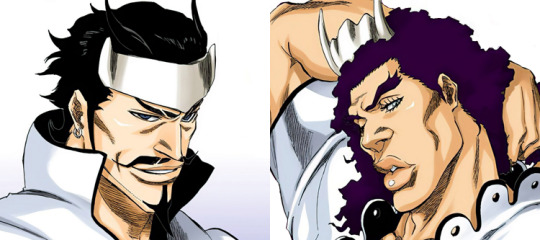
...
Dordonii might seem like a weird one to point out here, compared to some of the more overt examples, but I think he had a fairly evident queer codedness to him. His more overwhelming quality was his kind of Spanish flair, what with the tap shoes and Flamenco-esque poses and gestures, the devil horns in his greased hair and on his mask shard, and his little Mephistopheles mustache and beard. But the ear ring, and Flamenco adjacent sex appeal mixed with the way he kind of baby talks Ichigo strikes me as contributing to a certain daddy-ish gay character type. Also, I’ve never been 100% sure that it’s not just crosshatching, but I’ve always read it as some chest hair peaking out from his low v-neck. But I feel like that assessment needs some qualifying context...
Western sensibilities tend to read effeminate features on men as a chief indicator of homosexuality, Japan has never been quite as narrowly focused with its own gay stereotypes. There is definitely a particular character type in anime and manga that pins the preening vanity of smooth faced and long haired effeminate men on homosexuality, but it’s not really the go-to. Tracing back to media trends of the 1970s the long haired, smooth chested pretty boy (even the gay ones) very much became the domain of female audiences and creators, where as the prevailing trends of gay portrayals by and for men actually settled more firmly on the hairy and muscular image that bara is associated with now. I'm not about to do a whole big breakdown of the japanese gay subculture behind the bara thing, because that deserves more time and attentio that i can give it here, but you've got a keyword to work with now, so I encourage you to do a little googling yourself.
Also he has his right ear is pierced? I don't know if this was ever a thing in Japan, but in America it became kind of a wide spread myth(?) Originally it actually was a functioning kind of code within the queer community in the 1960s and 70s, but after it became somewhat more generally well known the practice more or less stopped, for pretty obvious practical reasons... but weirdly enough by the sheer power of stupid homophobia, straight people continued to scrutinize and be paranoid of men with pierced ears for decades following. Again, though, I have no idea if either the original intent or the misinformation of that trend was ever anything that had any kind of Japanese presence...
Anyway... What I’m getting at is Dordonii feels very queer coded to me, just not in ways that everyone picks up on. But speaking of muscular hairy gays... Let’s talk about an elephant in the room:
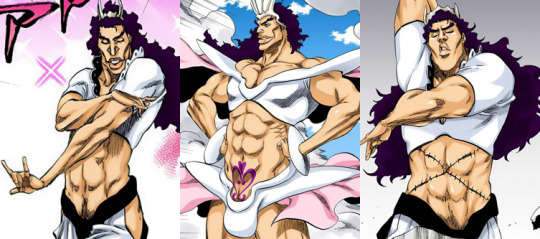
Charlotte Chuhlhourne:
Obviously, Kubo doesn’t quite have the tact to make use of queer identities in a totally respectful way, so it’s hard to tell how much is attributable to Kubo making a character exactly as they appear, and what could be argued to be a character’s theoretical self-identifying terms filtered through Kubo’s limited vernacular. But the word to know here is Okama[オカマ], which has traditionally referred to gay, AMAB transvestites. Obvious stumbling point here is that prior to more widely codified and accepted trans identities this term applied to both transwoman and drag queens.
Granted until fairly recently(by which I mean within the relatively short spand my own lifetime) even the queer community at large didn’t always differentiate the two very well; presentation was presentation, the circumstances for it and the specificities of achieving it were personal choices, not taxonomical crossroads; some moonlit as queens and that was it, others would’ve lived as women and never walked a show in their life if that had been a practical option, others still were happily gender fluid, but the scene had one look and one label. We made due with what we had.
Anyway... point being that Charlotte’s character is specifically a play into an Okama stereotype. That is to say, the archetypal look of Okama in Japanese media for many years has been a middle aged, square jawed, often broad or even muscular, drag queen. Although Charlotte doesn’t actually have one, they are also frequently shown with a muzzle of stubble growing in. Despite what you might think about jabs at the beard as a masculine feature betraying their feminine presentation, it’s actually not (usually) the reason...
The image comes out of Japan’s gay bar scene --in Tokyo, Shinjuku-Nichoume in particular-- which has long been a cultural centerpiece of Japan’s gay culture. The larger Shinjuku ward as as whole is itself a commercial district. So, to the general public who didn’t have any interaction with gay culture itself, the small glimpse they had was from the crossing paths of salarymen commuting into work as straggler okama headed home from the bars the morning after, still in drag and makeup but with unshaven stubble growing in after a long night.
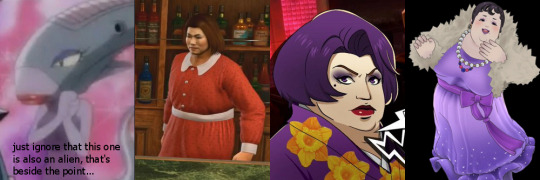
(Also, just a side note on this, but if you’ve ever seen an older (usually bigger) woman with a deep, brassy voice in kind of sultry night attire at a bar referred to as “Mama,” it’s because that’s the owner of a okama bar. She’s not literally anyone’s mother, she’s the defacto den-mother of sorts for the patrons of her bar.)
It’s still definitely not a flattering portrayal, but it’s one with a very specific history that doesn’t communicate to Western audiences at all. But there is a certain strangeness to how the Japanese handle this, comparatively. While Western rhetoric has its hangups with moralist preaching and bitching and moaning about “degeneracy” and “deviancy,” those judgments just aren’t baked into Japanese culture in quite the same way. In fact, while most of these okama caricatures by and for cishetero creators/audiences are definitely not what anyone would call “good” representation, they do lack a certain expected malice. Sure, flamboyant bafoonery is a constant in exploitation of gay culture on either side of the Pacific, but where as the West uses this as a means to disarm gay men --to make them non threatening, or to rationalize not taking them seriously-- anime manga and even videogames tend to fixate on the curiosity of it.
(although one enduring, generally positive case of this that actually seems to fly super under western audience’s radars are the great fairys in Zelda. which have maintained their extremely obvious dragqueen inspired look since OoT)

One of the first encounters with the okama charactertype that I only learned to identify looooong after the fact is the Magypsies (haha oh boy that localized choice of slur...) in Earthbound. On the one hand they were treated as a bizarre spectacle and literally not human, but they were magical and benevolent and a little comical but not in the way where they were relegated to being the punchline of a joke and nothing else. And I've found over the years that that tends to be the tone of these kinds of characters.
Another very similar case of this is Ivankov in One Piece, the Kamabakka kingdom Okama and Newkama, including Bonclay/Mr.2. (His "okama way" gimmick being a play on the hardboiled gritty actionhero cliche of a "man's way.") Where on the one hand, it’s a disgusting, tacky use of the familiar okama cliches, but also their very existence as okama is painted as the basis of their unique form of super power? Really, it’s just so wildly divorced from reality that it’s hard to even call it “representation,” harmful or otherwise... Still, in impossibly poor taste based on optics alone, though.
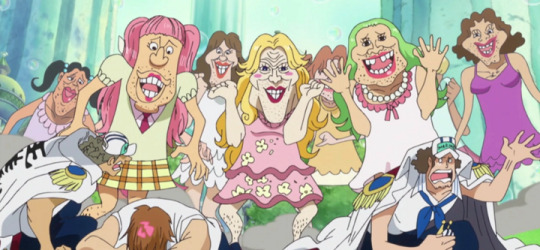
This all is not to try and sweep under the rug that these are still ultimately problematic stereotypes and caricatures to have to debrief each new generation of viewer on just to avoid the slippery slope of total misinterpretation, but I've noticed that there is a distinct difference in how that tone is read. The overwhelming attitude I see from these creators is that these long standing cliches are how okama look and act, but that it makes them interesting or funny, and yes “other,” but rarely lesser. Obviously that's still rooted deeply in ignorance on part of these non-queer creators, but you can see how it lacks the teeth that the western equivalent has, where such caricatures are explicitly there to defame and demonize, and I think that’s an important distinction to make.
(And let’s not even get into the issue of fake “woke” white people struggling to wrap their tiny brains around the idea of another culture by framing it as that culture’s unique idiosyncrasies as if they’re just failed attempts at conforming to white anglo-centric western values, because THAT is a whole other can of worms...)
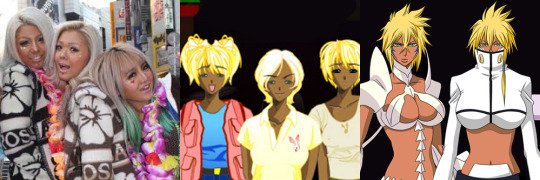
To maybe put this into some better perspective here, Tier Harribel has blond hair and tan skin, and given what the Arrancar are and how they live she is presumably naturally dark skinned, and naturally blonde. But her design is clearly based on gyaru/gal (or possibly ganguro) fashion, which makes use of fake tans and bleached hair. She looks the way she does because she's made to look like that aesthetic, but looking the way she doesn't doesn't imply she bleaches and tans(presumably those colors are both natural on her in-world).
That same relationship of image inspiring image while being divorced from meaning is just kind of how Kubo makes these kinds of aesthetic decisions, all across the board, problematic or not. But of course no one really cares about it when it’s a weird recontextualization of the gal aesthetic because no one’s offended on their behalf.
And in general, I think a lot of these things are just so outside the Western perspective that even when they definitely are problematic, some people can’t even begin to grasp what about it is, and end up fabricating just nonsense arguments against it to rationalize a kneejerk kind of discomfort and confusion over the subject...
Anyway... having said all that, the next one actually IS a huge problem...
[1][2][3]
#bleach meta#bleach#KUBO TITE#Dordoni Alessandro Del Socaccio#Charlotte Chuhlhourne#now that its posted#the more i look over this the more i want to edit it#but if i start it'll quickly become just a totally different post#its not even that im looking to correct the basic points being made#so much as i just hate the voice#but then thats always my beef with my own writing#i really hate the way i worded the whole okama bit though#it feels like it doesnt really get the point across#oh well....
86 notes
·
View notes
Text
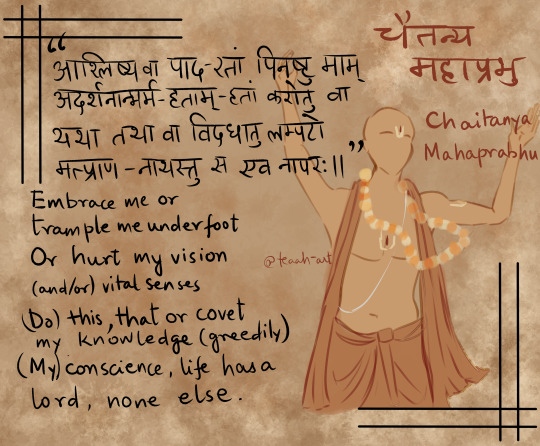



Desi LGBT Fest 2023 (hosted by @desi-lgbt-fest)
Day 7 : Faith/Rituals of Love
Definitely geared heavily towards the 'Faith' part of this prompt as soon as I read it!
If being Queer is defying conventions and if being a part of the Queer community means going against heteronormativity and gender conformity, is it not Queer to forego materialistic ties and the love of a human partner and embrace the love of a greater being you have only heard about in stories?
All four individuals featured here were integral part of the Bhakti Movement and/or Sufism in South Asia. None were married other than Meerabai.
(Panel order from top to bottom)
Chaitanya Mahaprabhu (1486-1534) : A key name of the Bhakti Movement and the Gauriya Vaishnav tradition in 15th Century Bengal, Chaitanya Mahaprabhu was believed to have been a vessel for both Radha and Krishna. Bengali doesn't use pronouns or gendered language and we may never know what they would have preferred to be identified as in a language they didn't know (English), I will simply resort to using They/Them for them. Their written teachings are few and far between but the verse mentioned here is the seventh verse of the only written record of their teachings, the Shikshastakam - a collection of 8 total verses. The translation here is my own and quite literal so that the interpretation is left to the reader.
Meerabai (1498-1597) : [CW : IMPLIED QUEERPHOBIA/APHOBIA] Meerabai was born into Rajput royalty and was married off, also to Rajput royalty, in likely an arranged marriage. While most of the stories surrounding her are folklore whose historicity is yet to be confirmed, her marital status can be confirmed, and so can her devotion and affection for Krishna and the divine, which she has herself penned in numerous poems and songs. Folklore does strongly imply that she was non-committal to her marriage and that her in-laws tried to poison her to death multiple times for it.
Kabir (1398–1448 or 1440–1518) : Found as an orphan by a Muslim weaver couple, Kabir's religion grew to become somewhat of an enigma for future generations. His stance, however, on the topic romance and marital relationships is quite clear - he looked down upon them and a huge chunk of his couplets strongly imply that romantic and sexual relations simply obstruct spiritual enlightenment.
Bulleh Shah (1680-1757) : Bulleh Shah, though an ardent proponent of loving the divine, was declared a Kafir, a non-believer/non-Muslim by a quite a few Muslim clerics of the time. He was known for speaking up against existing power hierarchies of the time and used vernacular speech for his writings (Punjabi, Sindhi) which not only served to popularize his works, but also let people connect to his words.
A personal note on my motivations under the cut.
A while back when I was actively going through the anxiety of finding out that I am ace and that I will never fit into the current South Asian society that the wedding industry has a chokehold on, I desperately wanted to see people from my own culture living happily without a partner. During one of my history rabbit hole escapedes, I restumbled upon the story of Meerabai, how she always insisted on loving and devoting herself towards Krishna, despite being married into a normative and wealthy household and despite her in-laws repeatedly attempting to poison her for not committing to her husband. Most of us from India grow up hearing about Meerabai, her spiritual connections to Krishna, and her struggles. The moral of those stories is always framed as 'believe in god, he will help you through tough times'. But this was the first time I was making a different connection, I was drawing different morals. And when I took Meerabai's non-conformity to her married life and started looking for more examples like hers, I was overwhelmed by how many more individuals existed without a partner, condemned being in a normative, married relationship, admitted to having lost human connections and faced resistance even, and yet stayed true to their orientation and sounded HAPPY! It was extremely hard to narrow it down to these four, but these do make my point! Labels are hard to transpose across cultures and history. But if being queer means being nonconforming of marital structures and being aspec/arospec implies neutrality, indifference, or aversion to romance and intercourse, then no one fits the label if they don't.
#desilgbtfest23#desi lgbt#desi lgbtq fest#long post#pride 2023#pride#original art#my art#meerabai#meera bai#sant kabir#kabir#kabirdas#bullehshah#bulleh shah#chaitanya mahaprabhu#bhakti movement#sufism#sufi#tw implied aphobia#tw mild aphobia#tw implied homophobia#btw if someone notices errors in my Shahmukhi or Gurumukhi on the Bulleh Shah illustration pls let me know#I do not speark or read or write Punjabi and I copied
82 notes
·
View notes